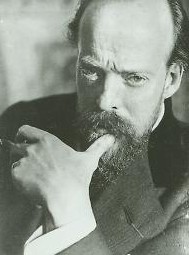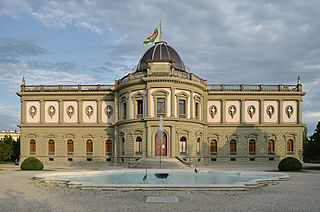Yves Jumeau | |
|---|---|
 | |
| Born | 7 August 1955 |
| Nationality | French |
| Known for | Installation Art, Sculpture, Glass Casting |
Notable work | Kundalini |
Yves Jumeau is a French artist who was born in 1955 in Le Mans, France
Yves Jumeau | |
|---|---|
 | |
| Born | 7 August 1955 |
| Nationality | French |
| Known for | Installation Art, Sculpture, Glass Casting |
Notable work | Kundalini |
Yves Jumeau is a French artist who was born in 1955 in Le Mans, France
Son of a glass-work master, Yves was initiated to arts from his earliest days. He was five years old when he created his first stained glass panel. While he was studying, he collaborated from time to time with his father to the creation and restoration of stained glass. [1]
He had many different professional experiences, among which being the director of a company, which didn't give him any satisfactions corresponding to his aspiration. He thus stopped those activities and undertook studies in electronics. He graduated in sound engineering and show technician light manager. “Of this development, derives nowadays all the freedom we find in his artistic expression”, considers Jung-Chou Lin. [2]
Yves Jumeau as a self-taught person, dedicates all his energy to glass work, in a new way, that of volume, of sculpture. Since May 1984 his work have been exhibited (Le Mans congress centre, Vittel,...), and they appeared for the first time in galleries in 1986 (Galerie Art Objet in Angoulême, Galerie Artitude in Paris). [3]
Yves Jumeau explored many fields in contemporary art. He made sculptures, installation art, organized events (Tree of knowledge est mort, [4] A ma Lulu forever [5] ...), and he also contributed to stage lightning for the movie art industry. He is a specialist of glass casting, and his works include such medias as metal, bronze, plaster, fabrics, sound environment, x-rays, etc.
“From the smallest, we get into gigantic works with his monumental glass settings for public places. For Yves Jumeau’s creativity has no limit, he displays statues for us, faces, which are several meters high, held up by an inner stainless steel structures, worthy of the Statue of Liberty” considers Christian Germak. [6]
His work on crystallization, starting in 2008, is a meeting point with Marcel Duchamp’s ready-made concepts. Yves Jumeau’s crystallization concept consists covering emblematic objects with glass crystals, thus creating a coating which expresses both time passing by and protection. The object is thus petrified and plunged into “a sort of fixation of time and space”.
“Yves Jumeau’s art work is a way of appropriating objects, concepts and environments. It is a way of absorbing them, phagocyte them to present them to us, deprived of the function and temporality. Their symbolic value is thus protected for eternity as it seems”, considers Hsu. [7]
Rolls-Royce, clothes, art objects, etc. are privileged supports for crystallization.

Jacques Laffitte was a leading French banker, governor of the Bank of France (1814–1820) and liberal member of the Chamber of Deputies during the Bourbon Restoration and July Monarchy. He was an important figure in the development of new banking techniques during the early stages of industrialization in France. In politics, he played a decisive role during the Revolution of 1830 that brought Louis-Philippe, the duc d'Orléans, to the throne, replacing the unpopular Bourbon king Charles X. Laffitte was named president of the new Citizen King's Council of Ministers and Minister of Finances. After a brief ministry of 131 days, his "Party of Movement" gave way before the "Party of Order" led by the banker Casimir-Pierre Perier. Laffitte left office discredited politically and financially ruined. He rebounded financially in 1836 with his creation of the Caisse Générale du Commerce et de l'Industrie, a forerunner of French investment banks of the second half of the 19th century such as the Crédit Mobilier (1852). The Caisse Générale did not survive the financial crisis caused by the Revolution of 1848.

Philippe de La Hire was a French painter, mathematician, astronomer, and architect. According to Bernard le Bovier de Fontenelle he was an "academy unto himself".

Carlos Schwabe was a Swiss Symbolist painter and printmaker.

Arman was a French-born American artist. Born Armand Fernandez in Nice, France, Arman was a painter who moved from using objects for the ink or paint traces they leave to using them as the artworks themselves. He is best known for his Accumulations and destruction/recomposition of objects.

Raymond Hains was a prominent French visual artist and a founder of the Nouveau réalisme movement. In 1960, he signed, along with Arman, François Dufrêne, Yves Klein, Jean Tinguely, Jacques Villeglé and Pierre Restany, the Manifesto of New Realism. In 1976, the first retrospective exhibition dedicated to Hains’ work was organized by Daniel Abadie at the National Center of Art and Culture (C.N.A.C.) in Paris. Hains named the show, which was the last one to be displayed at the C.N.A.C., La Chasse au C.N.A.C.. For it, Daniel Spoerri organized a dinner entitled La faim au C.N.A.C..
Daum is a crystal studio based in Nancy, France, founded in 1878 by Jean Daum (1825–1885). His sons, Auguste Daum (1853–1909) and Antonin Daum (1864–1931), oversaw its growth during the burgeoning Art Nouveau period. Currently Daum is the only commercial crystal manufacturer employing the pâte de verre process for art glass and crystal sculptures, a technique in which crushed glass is packed into a refractory mould and then fused in a kiln.

Jean-Michel Othoniel is a French contemporary artist born in 1964 in Saint-Etienne. He lives and works in Paris.

Herve Yamguen is a Cameroonian painter and sculptor. Autodidact, he launched himself in painting, sculpture and he discovered a passion for the writing which enables him to wonder about its daily live. He currently works on plays.

The Musée Ariana, also known as the Musée suisse de la céramique et du verre, is a museum in Geneva, Switzerland. It is devoted to ceramic and glass artwork, and contains around 20,000 objects from the last 1,200 years, representing the historic, geographic, artistic and technological breadth of glass and ceramic manufacture during this time. The collection is the only one of its kind in Switzerland.
Philippe Beck is a French poet, writer and professor for Philosophy at University of Nantes, in France and European Graduate School in Saas-Fee, Switzerland.

Annie Lacroix-Riz is a French historian, professor emeritus of modern history at the university Paris VII - Denis Diderot, specialist in the international relations in first half of the 20th century and collaboration. Her work concerns the political, economic and social history of the French Third Republic and Vichy Government, the relations between the Vatican and Reich, as well as the strategy of the political elites and economic French before and after the Second World War. She is also known for her communist commitment. She denounces contemporary history under the alleged influence of the world of finance. However, she is criticized by many historians because she is considered politically biased, inclined to be revisionist about supposed communist crimes and a believer in the Synarchist conspiracy theory.

Jean-Yves Mollier is a French contemporary history teacher.

Antoine de Vinck, Baron, was a Belgian ceramist, designer and sculptor.

Notre-Dame de Clignancourt is a Roman Catholic church located in the 18th arrondissement of Paris. Completed in 1863, the church takes its name from Clignancourt, a small village in the commune of Montmartre that was annexed to Paris in 1860. It was one of three new parishes created to accommodate the growing population in the northern edge of the city.
Élisabeth Cibot is a French sculptor and art historian.
Alfred Barye "Le Fils" or Alf Barye was a French sculptor, of the Belle Époque, pupil of his father the artist Antoine-Louis Barye. In cooperation with Émile-Coriolan Guillemin, Barye did the artwork for "The Arab Warrior Knight on Horseback". Included in Barye's oeuvre were animalier bronzes as well as Oriental subjects. At his father's request, he signed his work as "fils" to differentiate his work from his father's.

Philippe Perrin is a French contemporary sculptor and photographer who lives and works in Paris. His works are in the collections of the Maison Européenne de la Photographie in Paris and the Musée d'art contemporain de Lyon.
Bernard Lamarche-Vadel was a French writer, poet, art critic and collector.

Maxime Old (1910–1991) was a French interior architect and furniture designer. He is known for his numerous works of art, and as forerunner of the transition from the style of the 30s to modern design. Yves Badetz, chief curator at the Orsay Museum, in charge of decorative arts, confesses that “The emotions you feel when looking at Maxime Old’s creations are intense. His thoughtful esthetics freely associates the values of the rational of Bauhaus with Ruhlmann's demand for perfection. His talent is to design the refined outlines anticipating the third millennium."

Art Nouveau glass is fine glass in the Art Nouveau style. Typically the forms are undulating, sinuous and colorful art, usually inspired by natural forms. Pieces are generally larger than drinking glasses, and decorative rather than practical, other than for use as vases and lighting fittings; there is little tableware. Prominently makers, from the 1890s onwards, are in France René Lalique, Emile Gallé and the Daum brothers, the American Louis Comfort Tiffany, Christopher Dresser in Scotland and England, and Friedrich Zitzman, Karl Koepping and Max Ritter von Spaun in Germany. Art Nouveau glass included decorative objects, vases, lamps, and stained glass windows. It was usually made by hand, and was usually colored with metal oxides while in a molten state in a furnace.